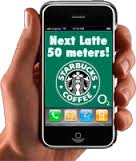The Survival of the Shopping-Malls

Imagine a project developer, Mrs. Smith, who is developing a shopping-mall with her team. Mrs. Smith wants to attract future customers (and storeowners) by offering them a personalized and comfortable shopping experience. First of all she wants to achieve this by offering her future customers access to high quality Wi-Fi for free. Furthermore, she wants the future storeowners to have the ability to target specific types of customers with personalized advertisement (e.g. coupons and discounts). Moreover, she wants her storeowners to have consumer insights, for example into the type (e.g. age, sex and education) of customers that visit their shops.
A new emerging technology will help her to accomplish this. By designing the Wi-Fi network in such a way that it’s able to collect user data, like their location and demographics, this can be made possible (Rodriguez 2015). The localization of the customers can be obtained with a technology called ‘triangulation’ (Keppel 1975). The customer demographics can be obtained by giving visitors access to Wi-Fi, by connecting to Facebook or email.
Location-based advertising (LBA) is a technique that can be used to offer personalized advertisement. LBA uses mobile devices to offer location specific advertisement (Harmon 2013). The following video demonstrates how LBA works:
Developers like Westfield, one of world’s largest mall operators, are exploring such services in their malls (“smart malls”). The VP-CMO Mrs. Kaminkow says: “It’s important for us to stay at the pace of cultural and technological changes” (Rodriguez 2015). Furthermore, the article says that offering free Wi-Fi, mall owners are gaining access to data that offer insights into customers’ habits. The shopping-mall can build broad profiles of its customers, which can anticipate what a customer wants and advertise accordingly.
Vector Media, a company that offers diverse out-of-home advertising opportunities, will be adding LBA through a new partnership with Gimbal, a company that develops technology regarding mobile engagement. Vice-president Mr. Greenstein states: “This technology is incredibly powerful for our advertisers, allowing them to reach not only the right people at the right time, but at exactly the right place” (ScreenMedia daily 2015).
The first steps have been taken, but the so-called location-based advertisement isn’t very common yet.  Furthermore it is not yet so accurate that it can precisely locate a customer within one meter (Krishnamurthy 2015). This will be interesting for storeowners that, for example, want to know what products get the most attention. More can be developed though. Imagine knowing when a customer arrives who is picking up an order. The guest could be guided to the nearest parking spot, the storeowner could be warned to prepare their order and the customer receives a coupon for a coffee on his way.
Furthermore it is not yet so accurate that it can precisely locate a customer within one meter (Krishnamurthy 2015). This will be interesting for storeowners that, for example, want to know what products get the most attention. More can be developed though. Imagine knowing when a customer arrives who is picking up an order. The guest could be guided to the nearest parking spot, the storeowner could be warned to prepare their order and the customer receives a coupon for a coffee on his way.
This way of advertising has a wide range of opportunities to engage with the customers at a deeper level (Rodriguez 2015). LBA explores and provides services that merge the digital and physical worlds to further engage shopping. The customers have access to free Wi-Fi, and storeowners can use targeted advertisement. One could say that there is a so-called win-win situation,  but according to privacy concerns, we have to reconsider this. When customers gain access to Wi-Fi the customer has to accept the conditions. By accepting the conditions one grants access to a lot of their information. People may experience some loss of control, even though they have accepted the conditions, which is called ‘terms of service’, themselves (Harmon 2013). Some may experience LBA as invasive to their privacy and as being intrusive.
but according to privacy concerns, we have to reconsider this. When customers gain access to Wi-Fi the customer has to accept the conditions. By accepting the conditions one grants access to a lot of their information. People may experience some loss of control, even though they have accepted the conditions, which is called ‘terms of service’, themselves (Harmon 2013). Some may experience LBA as invasive to their privacy and as being intrusive.
Arguments against LBA can be defused by naming the countless advantages of targeted personalized marketing. A similar form of marketing has actually been shown to take negative impacts of privacy concerns way after demonstrating the advantages (Ho and Kwok 2003). Research has shown that customers were pragmatic in their willingness to trade personal information for their own advantages, like customized discounts (Olivero and Lunt 2004). Furthermore, although customers may have privacy concerns, they often don’t look at the privacy policies at all (Jensen, Potts and Jensen 2005).
LBA can be seen as invasive of privacy, but a more optimistic point of view sees LBA as the saver of shopping-malls. Since 2010 dozens of shopping-malls have been closed due to the rise of online-shopping (Worstall 2015). Top-quality malls with some high-tech solutions are reporting higher sales in 2014 and hoping to continue this in 2015 (Rodriguez 2015). Current companies have the mission now to collect and make use of this valuable information about customers. This will help to improve their services and to design personalized offerings (Awad 2006). This may be seen as an argument of how marketers take away the concerns regarding privacy about LBA. Doing so is high-tech support, necessary for such companies to survive (Culnan and Armstrong 1999).

As it appears Mrs. Smith has a high chance to make her shopping-mall a success by focusing on a personalized shopping experience, where context is key. It can be said that with the emergence of technologies like LBA the environment (in this case a mall) will adapt to us, instead that we have to adapt to it. So let’s focus on the win-win situation: we get access to ‘free’ Wi-Fi by ‘selling’ some personal information, and at the same time storeowners obtain priceless insights that make sure they are in for the long run!
References
Awad, Naveen Farag. “The Personalization Privacy Paradox: an Empirical Evaluation of Information Transparency and the Willingness to be Profiled Online for Personalization.” Mis Quarterly. Vol 30 No 1 (2006): 13-28. September 6, 2015. <http://pingitsystems.com/PDF/Article34.pdf >.
Cisco Blogs. Explosive Growth in Mobility and Location-based Marketing. April 30, 2014. September 11, 2015. <http://blogs.cisco.com/wireless/explosive-growth-in-mobility and-location-based-marketing>.
Culnan, M. J. and P. K. Armstrong. “Information Privacy Concerns, Procedural Fairness, and Impersonal Trust: An Empirical Investigation.” Organization Science. 10 (1999): 104-115. September 6, 2015. <http://pubsonline.informs.org/doi/abs/10.1287/orsc.10.1.104>.
Egology – The Ideafarms Blog. Location-based Advertising. May 5, 2011. September 11, 2015. <http://blog.ideafarms.com/2011/05/05/a-quick-summary from%20navteq-developer’s-day/>.
Forbes. A New Spin On Location-Based Advertising. May 10, 2013. September 11, 2015. <http://www.forbes.com/sites/marketshare/2013/05/10/a-new spin-on-location-based-advertising/>.
Harmon, Robert. “Perceived Effectiveness of Push vs. Pull Mobile Location –Based Advertising.” Journal of Interactive Advertising. Vol 7 No 2 (2013). September 6, 2015. <http://jiad.org/article91.html>.
Ho, Shuk Ying and Sai Ho Kwok. “The attraction of Personalized Service for Users in Mobile Commerce: An Empirical Study.” ACM SIGecom Exchanges. 3 (2003): 10-18. September 6, 2015. <http://sigecom.org/exchanges/volume_3/3.4-Ho.PDF>.
Jensen, Carlos, Colin Potts and Christian Jensen. “Privacy Practices of Internet Users: Self-reports versus Observed Behavior.” International Journal of Human-Computer Studies. 63 (2005): 203-227. September 6, 2015. <http://www.sciencedirect.com/science/article/pii/S107158190 000650>.
Keppel, E. “Approximating Comples Surfaces by Triangulation of Counter Lines.” IBM Journal of Research and Development. 19 (1975): 2-11. April 6, 2010. <http://ieeexplore.ieee.org.proxy.uba.uva.nl:2048/search/searc result.jsp?searchWithin=%22Publication%20Number%22:5288 20&searchWithin=%22Volume%22:19&searchWithin=%22Issue 22:1&searchWithin=%22Start%20Page%22:2
Krishnamurthy, Prashant. “Technologies for Positioning in Indoor Areas.” Indoor Wayfinding and Navigation (2015): 35. September 7, 2015 <https://books.google.nl/books?hl=nl&lr=&id=I3oZBwAAQBAJ& =fnd&pg=PA35&dq=wifi+positioning+accuracy+overview&ots=y AINCeig9&sig=R2mXgDWvomvh10cZbBWst8G1NE4#v=onepag &q&f=false>.
Olivero, Nadia and Peter Lunt. “Privacy Versus Willingness to Disclose in E-Commerce Exchanges: The Effect of Risk Awareness on the Relative Role of Trust and Control.” Journal of Economic Psychology. 25 (2004): 243-262. September 6, 2015. <file:///Users/Willemijn/Downloads/SISTEMI1.pdf>.
ScreenMedia daily (author missing). “Vector Media Adds Beacons to Transit Advertising Network.” ScreenMedia daily. August 28, 2015. September 7, 2015. <http://screenmediadaily.com/vector-media-adds-beacons-to transit-advertising-network/>.
“Shuuga: An industry-leading location-based Smartphone advertising & voucher platform!” YouTube. June 2, 2013. September 11, 2015. <https://www.youtube.com/watch?v=Sh18a5Rbv7E>.
Rodriguez, Ashley. “Can Data Save the Mall?” AdvertisingAge. March 23, 2015. September 7, 2015. <http://adage.com/article/cmo strategy/data-save-mall/297697/>.
“Value-added Wi-Fi with location-based advertising.” YouTube. July 21, 2015. September 11, 2015. <https://www.youtube.com/watch?v=HfJQkbi3tE&index=5&list PLAA-xqb8ojQQ-_jsTJDVT52a0qOIyUNjv>.
Wikipedia. “Terms of service.” Wikipedia, the free encyclopedia. 2015. September 7, 2015. <https://en.wikipedia.org/wiki/Terms_of_service>.
Worstall, Tim. “The Shopping Malls Really Are Being Killed By Online Shopping”. Forbes / Economics & Finance. January 4, 2015. September 7, 2015. <http://www.forbes.com/sites/timworstall/2015/01/04/the shopping-malls-really-are-being-killed-by-online-shopping/>.